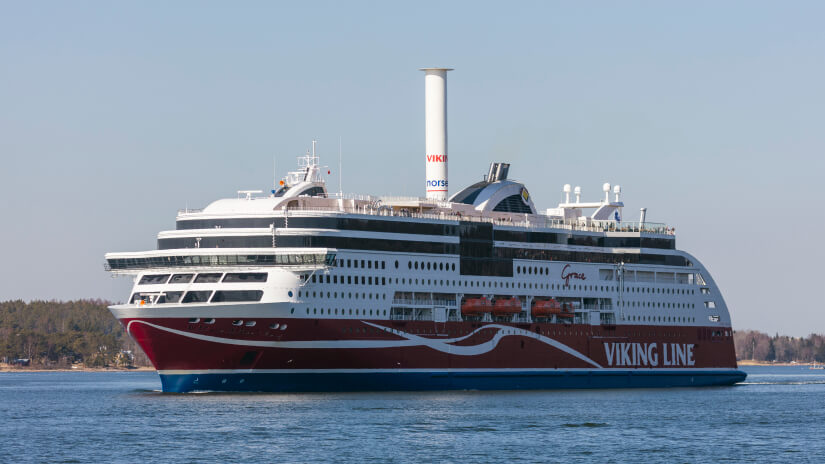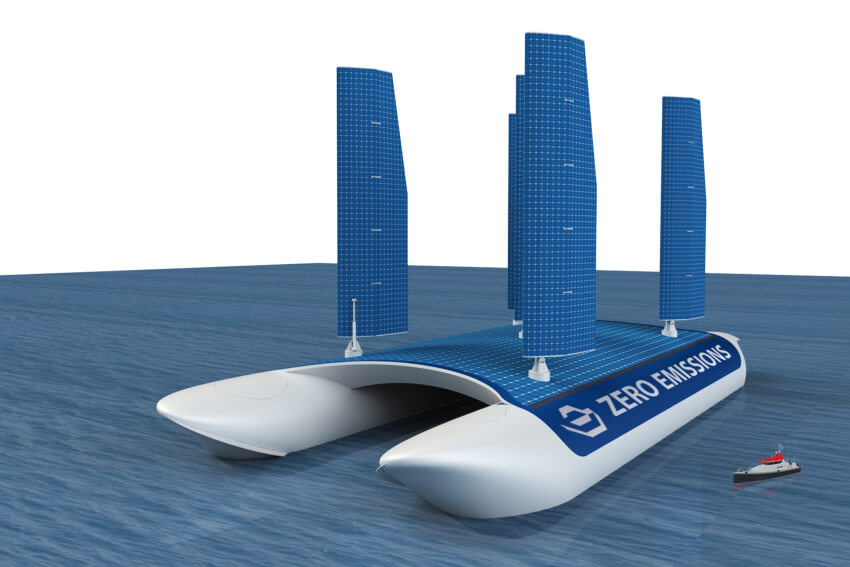14/01/2021
With wind power towards zero-emission maritime traffic
Ever-tightening environmental regulations, combined with the pressure to lower fuel costs, have made wind power an attractive option as transport energy for ships. Many sail applications have been developed, but no real breakthrough has been achieved. Suspected uncertainties have slowed the re-emergence of wind-based propulsion. However, there have been clear fuel economy benefits from the installations made. Emission reduction targets force the development and application of new environmentally friendly technologies, such as wind power in shipping.
Wind as a ship’s propulsive force
Of the solar radiation energy that reaches the earth, 2–3% is released into the wind. It is completely pure, unpolluted energy that is freely available. Before the era of motor ships, shipping was based on wind power. 100 years ago, the last sailing ships in active service reached peak speeds of up to 17 knots when sailing from Australia to Europe – a speed that modern bulk carriers cannot reach. At the same time, the world’s largest and fastest sailboats reached speeds of over 11 knots in yacht races. In cargo transportation, sail propulsion has been abandoned, while racing sailboats have developed tremendously, utilising advanced wing sails and light-weight structure technology. They reach top speeds of over 50 knots. The development of the use of wind power in ships was forgotten for 100 years, but interest in it has been revived.
Today, consumers are aware of environmental issues, which makes even large global suppliers demand environmentally friendly activities throughout the whole transport chain. This universal attitude has materialised in IMO’s (International Maritime Organization) target of halving maritime emissions by 2050. It drives the thinking of the whole maritime industry very strongly. Operators are looking for zero-emission solutions for propulsion power generation. This need is met by developers of wind energy-based equipment.
Conditions for wider deployment of wind power
Logistics chains are based on a precisely scheduled transport performance. On motor ships, this is easy to implement and achieve, although weather conditions can sometimes bring their own challenges. Sailing ships are completely dependent on favourable weather conditions. Instead of fully sail-powered propulsion, wind-assisted propulsion permits keeping to schedules. Hybrid solutions make it possible to achieve significant savings in fuel consumption and thus also in emissions. In practice, such hybrid solutions have been able to verify annual fuel savings of around 10% (corresponding reduction in CO2 emissions) cost-effectively, without reducing the service level of ship transportation.
If flexibility regarding schedule requirements can be introduced, the savings could be even greater. At its most extreme, all propulsion could be based on wind power – as it was before the era of steam engines and motor ships.
The most significant barriers to the uptake and wider use of wind propulsion are primarily related to various uncertainties. One is the price of fuel, i.e. the projected cost that needs to be reimbursed. In particular, the low price of fuel and its unforeseen fluctuations have dampened interest in the implementation of wind propulsion.
It is often questioned whether the proposed technology is at all suitable for ships and their operational profiles. Also, what is the usability of the devices, and how do they affect safety factors? These technical matters can be verified and tackled by accumulated information of every new pilot installation. Ultimately, investors require a “proven design” for a financially sound investment. The feasibility of proposed installations has to be carefully analysed and evaluated based on the vessels’ operation and environmental circumstances.
Sail-based or sail-assisted propulsion is one way of achieving carbon-neutral shipping.
Wind energy solutions
Traditionally, wind has been used on ships directly for propulsion power. The wind can also be harnessed to produce electricity with a turbine. However, the dimensions of such a device and, consequently, the height of the centre of gravity and the movements of a ship, do not allow a working combination to produce the needed electricity for a propulsion motor. Table 1 shows the different ways in which wind power can be utilised onboard.
There are more than 30 separate projects around the world studying or developing the use of wind power on ships. These projects are mostly being conducted by research institutes, but also by some commercial actors. Many of them are at a very low level of technological maturity. So far, there are hardly any commercially ready products on the market, besides sailing solutions derived from sail boats. One exception is Norsepower’s rotor sail. Based on the activity of the cluster, new solutions will be coming onto the market in the years ahead.
Classification societies have also done their work. The most significant classification societies have already published their guidelines and rules with respective notations for the classification of wind-assisted propulsion installations for different types of wind-assisted applications.
| UTILISATION OF WIND POWER | ||||||
|---|---|---|---|---|---|---|
| Means | Propulsive force | Electricity generation | ||||
| Type | Soft sail | Wing sail | Rotor sail | Kite | Axial turbine | Radial turbine |
| Application | Traditional sails | Hard sails, wing profiles | Flettner rotors | Towing kite systems | Windmill | Savonius wind turbine |
Assessing the benefits
Environmentally friendly technology creates benefits for society. However, wind power equipment must also be a commercially viable investment for the ship-owner, without reducing the level of ship performance. The payback time of the installation needs to be assessed. It, in turn, is heavily dependent on the price of fuel to be replaced by wind power. Unfortunately, fuel price fluctuations are large, making it challenging to predict future price levels reliably. In competition with fluctuating bunker prices, wind offers a more stable outlook, however, with uncertainties related to individual voyages.
Most wind-powered devices are currently at very early stages of development. The productization and series production of different types of equipment will create new opportunities and further improve their price competitiveness.
At the realised fuel cost levels, the payback times for the equipment have proven to be reasonable, but the value of the installation improves when the fuel price is high. Each case must be assessed individually, however, based on the ship’s operational profile and wind conditions in the operational area, in addition to the ship’s characteristics.

Thoughts for the future
The paradigm of the whole current ship concept will change if the propulsive power of ships is produced only with wind power. The largest single component of operating expenses, i.e. fuel costs, will be excluded. On the other hand, compromising on speed raises the importance of capital costs as transportation performance declines. Achieving the maximum benefit affects the whole ship concept and its characteristics.
Based on the above, the thought can be taken even further. If a ship is rendered unmanned, another large item of operating expenses, i.e. the personnel costs, would be eliminated. At the same time, all facilities and systems related to living onboard and the ship’s personal safety equipment become unnecessary, contributing to reduced capital costs. As a small concession, the ship would be equipped with solar cells, batteries and electric thrusters for port operations and occasional calm weather. Based on this philosophy, Elomatic developed the concept of a sail-bulker, pictured below.
To achieve stability, the vessel is of the catamaran type. Both hulls are tubular and double hulled, with the second shell inside forming a cargo space. The bow and stern parts have a streamlined design for good seagoing characteristics. The deck and sails serve as a platform for solar cells. It is a futuristic concept study, which is important for testing and evaluating novel ideas and solutions. By testing ideas and calculating their feasibility, these now utopian concepts will be refined step by step into the workhorses of our seas, into emission-free means of transport. Although developments in the sector are swift, it seems that it takes very long for actual commercial installations to become widespread. The proposed emission reduction targets require faster development.
Sail-based or sail-assisted propulsion is one way to achieve carbon-neutral shipping. Various sail solutions are already a cost-effective way of producing part of the propulsion power. This share can be increased in the future, and in some cases wind power will undoubtedly be the main driving force again for some ships at least.
Every new sail-assisted propulsion installation paves the way for wind-assisted propulsion in general. The more data is gathered and knowledge of the use of such devices is gained in various sea and wind conditions, the better the benefits can be evaluated and verified. Technical barriers can be solved by researching, developing and testing.
The key element for wider utilisation of this pure energy is economic competitiveness. Some of today’s solutions have generated a return on investment for the shipowner in less than 5 years, which simultaneously reduced CO2 emissions by 10%. If the bunker price trends upwards and marine CO2 emissions are part of any carbon tax instrument or carbon emission trading, such as the European emissions trading system (ETS), it will result in a lucrative market for wind assisted propulsion system suppliers. This will also assist shipowners to reduce fuel costs.


